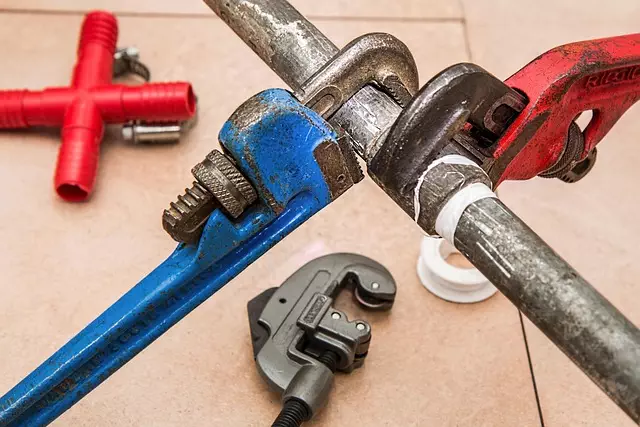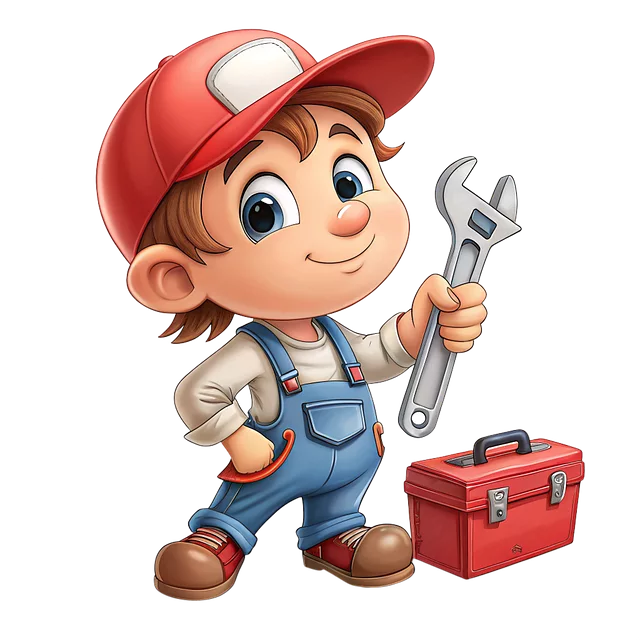This text provides a comprehensive guide to addressing pipe leaks, focusing on both DIY repairs and professional services. It emphasizes the importance of:
– Regular inspections to detect early signs of leaks or damage.
– Identifying leak types (e.g., slow drips vs. burst pipes) for targeted solutions.
– Safety precautions when repairing pipes, including protective gear and shut-off valves.
– Appropriate tool selection based on repair complexity, from basic kits to specialized tools for metal or intricate work.
– Step-by-step repair procedures, highlighting the importance of proper disassembly, cleaning, sealing, and testing.
– DIY vs. professional decisions, acknowledging limitations of DIY methods for complex leaks and the benefits of expert plumbers' knowledge and access to special equipment.
– Preventative maintenance practices like regular inspections, water pressure monitoring, and flushing to minimize leak risks.
Pipe leaks can cause significant damage and waste water, making prompt repair crucial. Understanding common causes, identifying leak types, and taking safety precautions are essential steps before beginning any pipe repair. This comprehensive guide covers everything from tools needed to DIY vs professional services, preventive measures, and when to call in expert help. Learn how to effectively address and prevent pipe leaks with these insightful tips tailored for both homeowners and professionals alike.
Understanding Common Causes of Pipe Leaks

Pipe leaks are a common household issue, often caused by various factors. Understanding these causes is the first step in effective pipe repair. One primary reason for leaks is aging pipes; over time, materials like metal or plastic can weaken, especially in harsh weather conditions, leading to fractures and seepage. Another frequent culprit is corrosion, where mineral deposits build up inside pipes, causing damage and ultimately resulting in leaks.
In addition, improper installation or maintenance can contribute to pipe leak problems. This may include faulty joints, loose connections, or inadequate sealing. Even minor cracks or defects can go unnoticed until water starts escaping, highlighting the importance of regular check-ups and prompt action for pipe repair.
Identifying Leak Types and Locations

Identifying the type and location of a leak is a crucial step in effective pipe repair. Different leaks can manifest in various ways, from subtle water stains to gushing streams. First, assess the visible signs around your pipes, such as dampness or mold growth, which could indicate a slow drip over time. These may be signs of internal leaks within walls or under floors. Conversely, sudden, powerful floods suggest a burst pipe, usually closer to the surface and easily locatable.
Using basic tools like flashlights and wire brushes, inspect pipes for visible damage, corrosion, or disconnections. Look for any abnormalities in joints, fittings, and valves, as these are common areas for leaks to develop. In older homes, metal pipes may be subject to rust, while newer plastic pipes can crack or become damaged during installation or due to extreme temperature changes. Identifying the leak’s nature and position is key to selecting the right repair method for effective and lasting pipe repair.
Safety Precautions Before Starting Repair

Before tackling any pipe repair, it’s crucial to prioritize safety. This is especially true for pipe leaks, as they can cause water damage and even pose health risks. Put on protective gear, including gloves, goggles, and a mask, to shield yourself from potential hazards such as rust or toxic fumes. Ensure proper ventilation in the area to prevent the buildup of harmful gases. Additionally, turn off the main water supply valve to stop the flow of water during the repair process, making it safer for you and helping to mitigate damage.
Remember, electrical safety is also paramount. Identify and turn off the circuit breaker or fuse responsible for powering any nearby electrical devices to avoid accidental shocks. Be mindful of wet surfaces, as they can be slippery; ensure good footing to prevent accidents. By following these simple precautions, you’ll create a safer environment for repairing your pipes effectively.
Tools and Equipment for the Job

When it comes to pipe leak repair, having the right tools and equipment is essential for a successful and efficient job. Start with a basic toolkit that includes wrenches, pliers, and screwdrivers in various sizes. These will be useful for removing access panels, tightening connections, and handling small parts. For more complex repairs, consider investing in specialized tools like pipe cutters, solder, and flux, especially if you’re dealing with metal pipes.
Additionally, a high-quality torch kit is invaluable for heating and fusing joints, ensuring durable repairs. Remember to also have some type of protective gear, such as gloves and safety glasses, to shield yourself from heat and potential hazards during the repair process. With the right tools at hand, you’ll be better equipped to handle pipe repairs with ease and confidence.
Steps to Fix a Leaking Pipe (Detailed Guide)

To fix a leaking pipe, start by locating the source of the leak. Turn off the water supply at the main shut-off valve to prevent further wastage. Then, inspect the pipe for any visible damage, corrosion, or cracks. If the leak is evident, like a bursting pipe, act swiftly as it could cause significant damage.
Next, gather the necessary tools and materials: a wrench, replacement pipes (if needed), pipe repair tape, and a bucket. Turn off the water again and prepare to disassemble the affected section of pipe. Clean the area thoroughly to ensure good adhesion for repairs. Apply repair tape or replace the damaged section with new piping, securing it tightly. Once complete, turn on the water supply at the main valve and check for leaks, ensuring your fix is effective before continuing with your daily activities.
DIY vs. Hiring a Professional Plumber

When it comes to pipe leak repair, the decision between DIY and hiring a professional plumber is an important one. For small, manageable leaks, some homeowners may opt for a do-it-yourself approach. This can be appealing due to cost savings and the sense of accomplishment that comes with fixing something yourself. However, DIY methods may only offer a temporary fix, and complex pipe repairs require specialized tools and knowledge.
Professional plumbers possess the expertise and experience needed to identify the root cause of a leak and provide a lasting solution. They have access to high-quality materials and advanced techniques, ensuring the job is done efficiently and effectively. While hiring a pro may come at a higher cost initially, it can prevent further damage, avoid costly future repairs, and ensure water efficiency in your home.
Preventive Measures to Avoid Future Leaks

Regular maintenance is key in preventing future pipe leaks. Start by inspecting your pipes for any signs of corrosion, cracks, or damage. Addressing these issues early can stop what might seem like minor problems from escalating. A simple check-up around your home or business premises can reveal potential risks and allow for timely repairs.
Additionally, keeping an eye on water pressure levels and regularly flushing out fixtures can help. Many leaks result from internal corrosion caused by high pressure or mineral buildup. By ensuring proper drainage and maintaining optimal pressure, you reduce these risks. Remember, regular pipe repair and maintenance are cost-effective measures that save you from more significant—and costly—issues down the line.
Common Mistakes to Avoid During Repair

When tackling pipe leak repair, it’s crucial to be aware of common mistakes that can arise and ensure a successful fix. One frequent error is attempting to fix the issue temporarily with quick patches instead of identifying and addressing the root cause. This can lead to recurring leaks and further damage over time. Proper evaluation and understanding of the leak’s origin are essential for effective pipe repair, ensuring longevity and preventing future costs.
Another mistake to avoid is neglecting proper preparation before starting the repair process. Insufficient sealing or improper use of compatible materials can compromise the fix. Always ensure you have the right tools, materials, and knowledge before beginning. Following guidelines from manufacturers or professional plumbing advice can significantly reduce risks and enhance the chances of a successful pipe repair.
When to Call in Expert Help

If you notice a persistent leak or water damage that can’t be easily pinpointed, it’s time to consider professional help. While DIY methods and temporary fixes are available for minor pipe repairs, complex leaks often require specialized knowledge and tools. An expert plumber can quickly identify hidden issues like broken pipes under flooring or behind walls, preventing further damage and costly renovations.
Calling in a professional is especially crucial when dealing with high-pressure water systems, gas lines, or if you suspect corrosion or damage to older plumbing. Plumbers have the expertise to access hard-to-reach areas, employ advanced repair techniques, and provide long-lasting solutions for efficient pipe repair.
